ESP PONTIAC GRAND-AM 1996 Owners Manual
[x] Cancel search | Manufacturer: PONTIAC, Model Year: 1996, Model line: GRAND-AM, Model: PONTIAC GRAND-AM 1996Pages: 356, PDF Size: 17.17 MB
Page 19 of 356
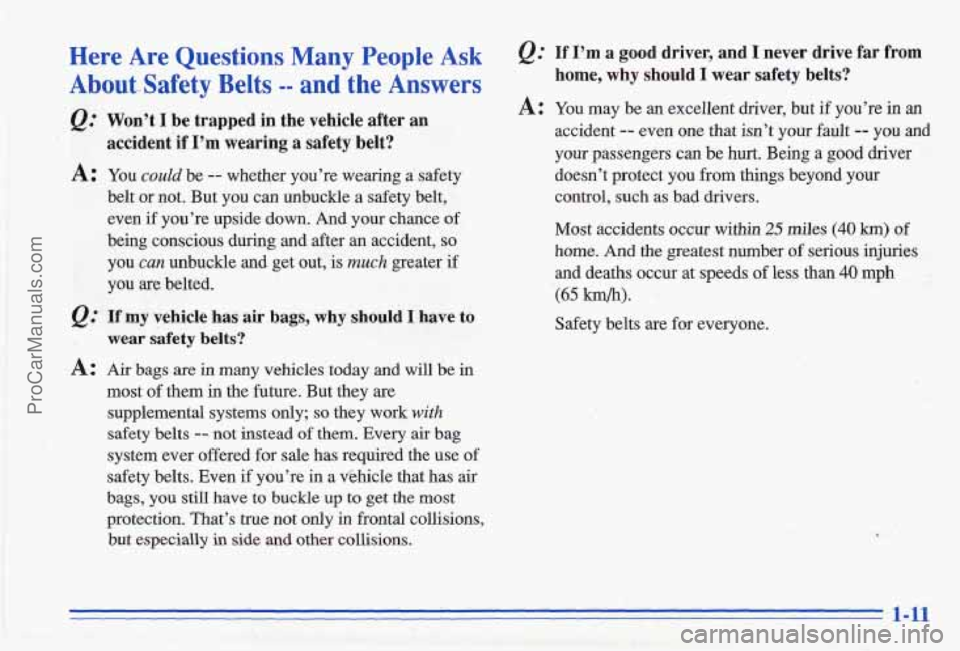
Here Are Questions Many People Ask If I’m a good driver, and I never drive far from
Aboutsafety Belts -- and the Answers home, why should I wear safety belts?
A:
Q.:
A:
Won’t I be trapped in the vehicle after an
accident’if I’m wearing a safety belt?
You could be -- whether you’re wearing a safety
belt or not. But you can unbuckle
a safety belt,
even
if you’re upside down. And your chance of
being conscious during and after an accident, so
you can unbuckle and get out, is much greater if
you are belted.
If my vehicle has air bags, why should I have to
wear safety belts?
Air bags are in many vehicles. today and will be in
most of them
in the future. But they are
supplemental systems only;
so they work with
safety belts --. not instead of them. Every air bag
system ever offered for sale has required the use of
safety belts. Even if you’re in a vehicle that has air
bags, you still have
to buckle up to get the most
protection. That’s
true not only in frontal collisions,
but especially in side and other collisions.
A: You may be an excellent driver, but if you’re in an
accident -- even one that isn’t your fault -- you and
your passengers can be hurt. Being a good driver
doesn’t protect you from things beyond your
control,
such as bad drivers.
Most accidents occur within
25 miles (40 km) of
home. And the greatest number of serious injuries
and deaths occur at speeds
of less than 40 mph
(65 h/h). ~
Safety belts are for everyone.
1-11
ProCarManuals.com
Page 59 of 356
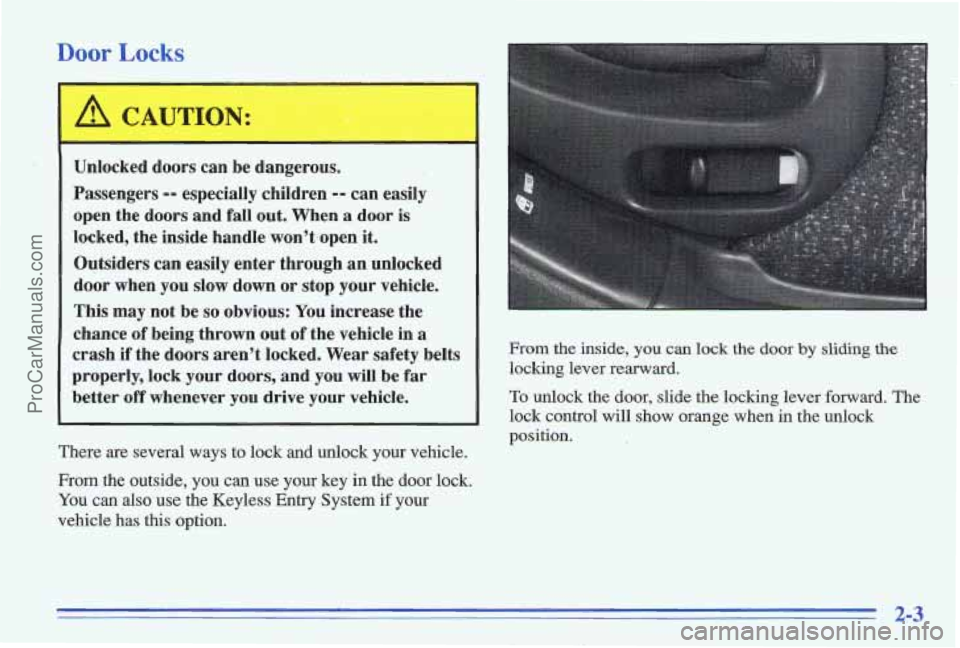
Door Locks
--
,+ I .. .. ,I
Unlocked doors can be dangerous.
Passengers
-9 especially children -9 can easily
open the doors and fall out. When
a door is
locked, the inside handle won’t.open it.
Outsiders can easily enter through an unlocked
door when
you slow down or stop your vehicle.
This
may not be so obvious: You increase the
chance of being thrown out of the vehicle in
a
crash if the doors aren’t locked. Wear safety belts
properly,
lock your doors, and you will be far
better off whenever you drive your vehicle.
There
are several ways to lock and unlock your vehicle.
From the outside, you can use your key in the door lock.
You
can also use the Keyless Entry System if your
vehicle has this option.
From the inside, you can lock the door by sliding the
locking lever rearward.
To unlock the door, slide the locking lever forward.
The
lock control will show orange when in the unlock
position.
2-3
ProCarManuals.com
Page 65 of 356
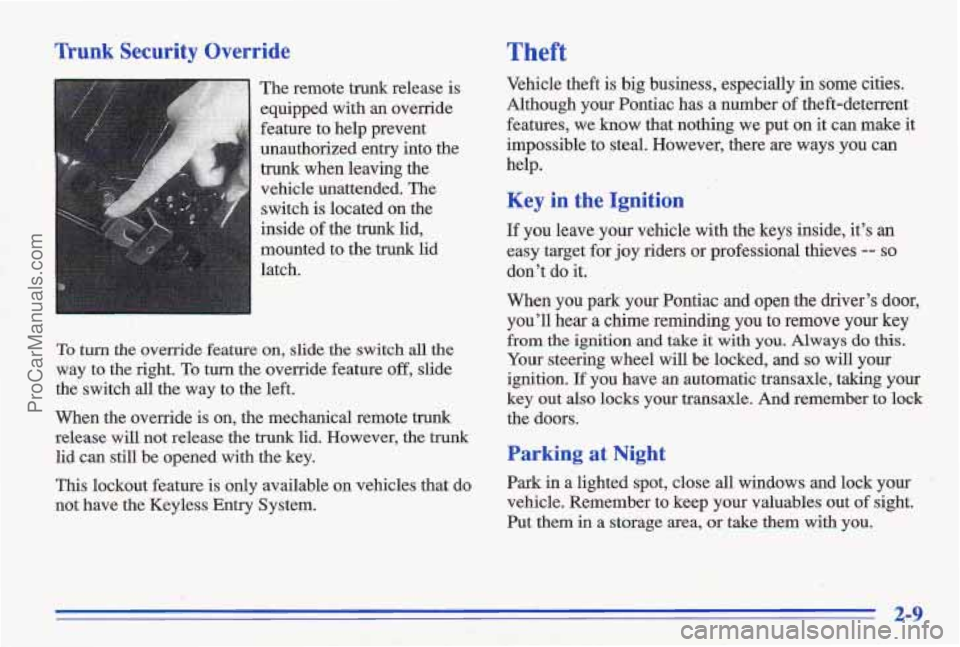
Trunk Security Override
The remote trunk release is
equipped with an override
feature to help prevent
unauthorized entry into the
trunk when leaving the
vehicle unattended. The
switch is located on the
inside
of the trunk lid,
mounted to the trunk lid
latch.
To turn the override feature on, slide the switch all the
way to the right.
To turn the override. feature off, slide
the switch all the way to the left.
When the override is on, the mechanical remote trunk
release will not release the trunk lid. However, the
trunk
lid can still be opened with the key.
This lockout feature is only available on vehicles that do
not have the Keyless Entry System.
Theft
Vehicle theft is big business, especially in some cities.
Although your Pontiac has
a number of theft-deterrent
features, we know that nothing we put on it can make it
impossible to steal. However, there
are ways you can
help.
Key in the Ignition
If you leave your vehicle with the keys inside, it’s an
easy target for joy riders or professional thieves -- so
don’t do it.
When you park your Pontiac and open the driver’s door, you’ll hear
a chime reminding you to remove your key
from the ignition and take it with you. Always do this.
Your steering wheel will be locked, and
so will your
ignition.
If you have an automatic transaxle, taking your
key out also locks your transaxle.
And remember to lock
the doors.
Parking at Night
Park in a lighted spot, close all windows and lock your
vehicle. Remember to keep your valuables out
of sight.
Put them in a storage area, or take them with you.
2-9
ProCarManuals.com
Page 96 of 356
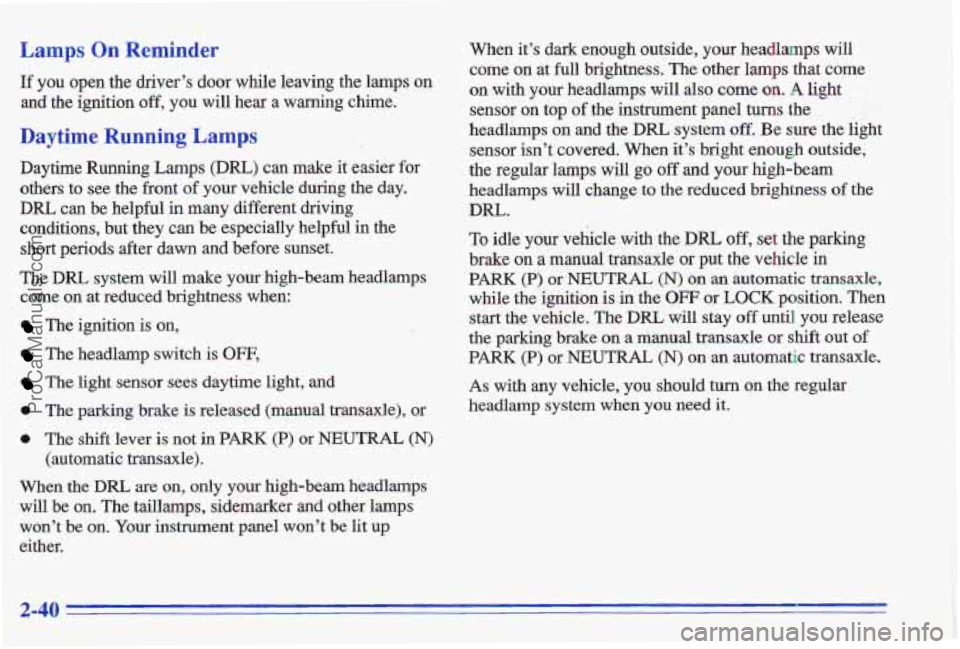
Lamps On Reminder
If you open the driver's door while leaving the lamps on
and the ignition off, you will hear a warning chime.
Daytime Running Lamps
Daytime Running Lamps (DRL) caw make it easier for
others to see the front of
your vehicle during the day.
DRL caw be helpful in many different driving
conditions, but they
can be especially helpful in the
short periods after dawn
and before sunset.
The
DRL system will make your high-beam headlamps
come
on at reduced brightness when:
The ignition is on,
, The headlamp switch is OFF,
The light sensor sees daytime light, and
0 The parking brake is released (manual transaxle), or
0 The shift lever is not in PARK (P) or NEUTRAL (N)
When the DRL are on, only your high-beam headlamps
will
be on. The taillmps, sidemarker and other lamps
won't be on. Your instrument panel wonY be lit up
either. (automatic transaxle). When
it's dark enough outside,
your headlamps will
come on at full brightness.
The other lamps that come
on with your headlamps will also come on. A light
sensor ,on top of the instrument panel turns the
headlamps oh and the DRL ,system off. Be sure the light
sensor isn't covered. When it's bright enough outside,
the regular
lamps will go off and your high-bem
headlamps will change
to the reduced brightness of the
DRL.
To idle your vehicle with the DRL off, set the parking
brake on
a manual transaxle or put the vehicle in
PARK (P) or NEUTRAL (N) on an automatic transaxle,
while the ignition is in the OFF or LOCK position. Then
start the vehicle, The DRL will stay off until you release
the
parking brake on a manual transaxle or shift out of
PARK (P) or NEUTaAL (N) on an automatic transaxle.
As with any vehicle,
you should turn on the regular
headlamp system when you need
it.
ProCarManuals.com
Page 145 of 356
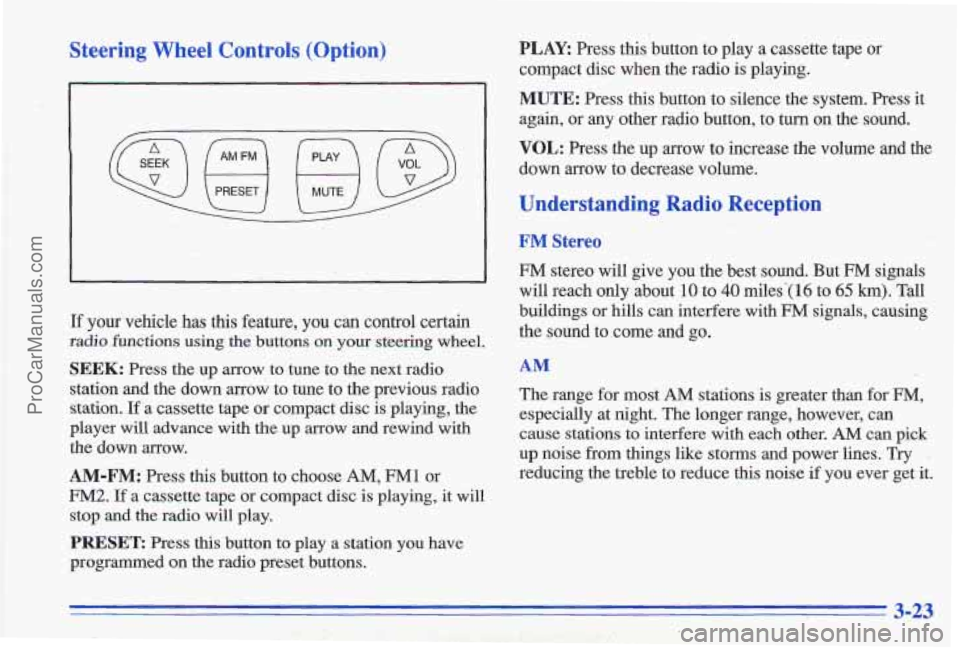
Steering Wheel Controls (Option)
.-
\u u/
If your vehicle has this feature, you can control certain
radio functions using the buttons on your steering wheel.
SEEK: Press the up arrow to tune to the next radio
station and the down
arrow to tune to the previous radio
station.
If a cassette tape or compact disc is playing, the
player will advance with the up arrow
and rewind with
the down arrow.
AM-FM: Press this button to choose AM, FM1 or
FM2. If a cassette tape or compact disc is playing, it will
stop and the radio will play.
PRESET Press this button to play a station you have
programmed on the radio preset buttons.
PLAY Press this button to play a cassette tape or
compact disc when the radio
is playing.
MUTE: Press this button to silence the system. Press it
again, or any other radio button, to turn on the sound.
VOL: Press the up arrow to increase the volume and the
down arrow to decrease volume.
Understanding Radio Reception
FM Stereo
FM stereo will give you the best sound. But FM signals
will reach only about
10 to 40 miles-( 16 to 65 km). Tall
buildings or hills can interfere with
FM signals, causing
the sound to come and
go.
AM
The range for most AM stations is greater than for FM,
especially at night. The longer range, however, can
cause stations to interfere with each other.
AM can pick
up noise from things like storms and power lines. Try
reducing the treble to reduce this noise
if you ever get it.
3-23,
ProCarManuals.com
Page 152 of 356
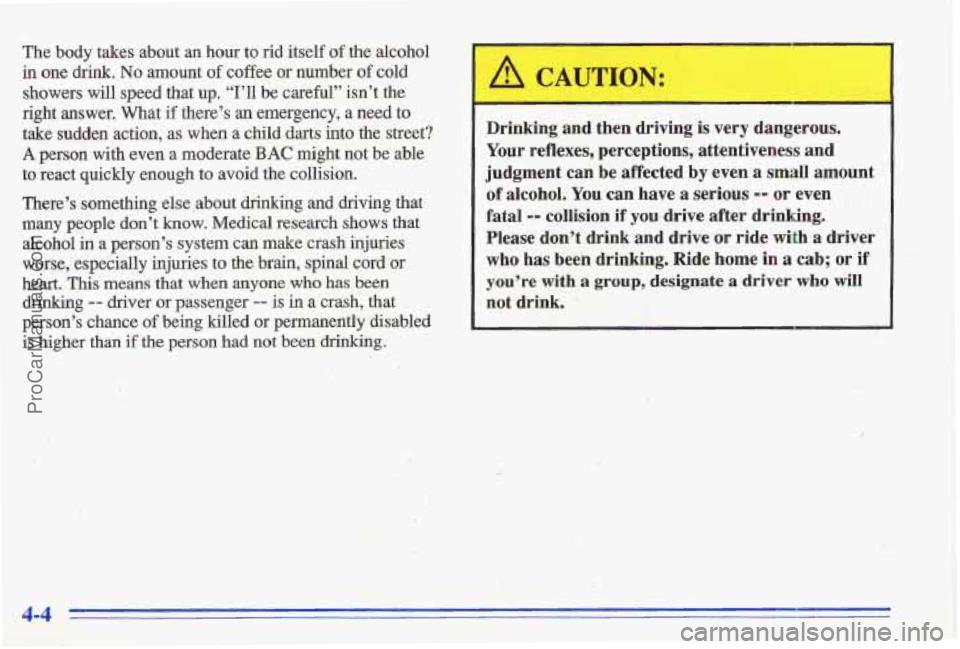
The body takes about an hour to rid itself of the alcohol
in one drink. No amount of coffee or number of cold
showers will speed that up. “I’ll be careful” isn’t the
right answer. What if there’s an emergency, a need to
take sudden action,
as when a child. darts into the street?
A person with even a moderate BAC might not b’e able
to react quickly enough
to avoid the collision.
There’s ssmething else.about drinking
and driving that
many people don’t know. Medical research shows that
alcohol
iria person’s system can make crash injuries
worse,‘espekially injuries to
the brain, spinal cord or
heart. This means that when anyone who has been
drinking -- driver or passenger -- is in a crash, that
person’s chance of being killed or permanently disabled
is higher
than if the person had not been drinking.
Drinking and then driving is very dangerous.
Your reflexes, perceptions, attentiveness and
judgment can be affected
by even a small amount
of alcohol.
You can have a serious -- or even
fatal
-- collision if you drive after drinking.
Please don’t drink
and drive or ride with a driver
who has been drinking. Ride home in a cab; or if
you’re with a group, designate a driver who will
not drink.
‘
4-4
ProCarManuals.com
Page 156 of 356
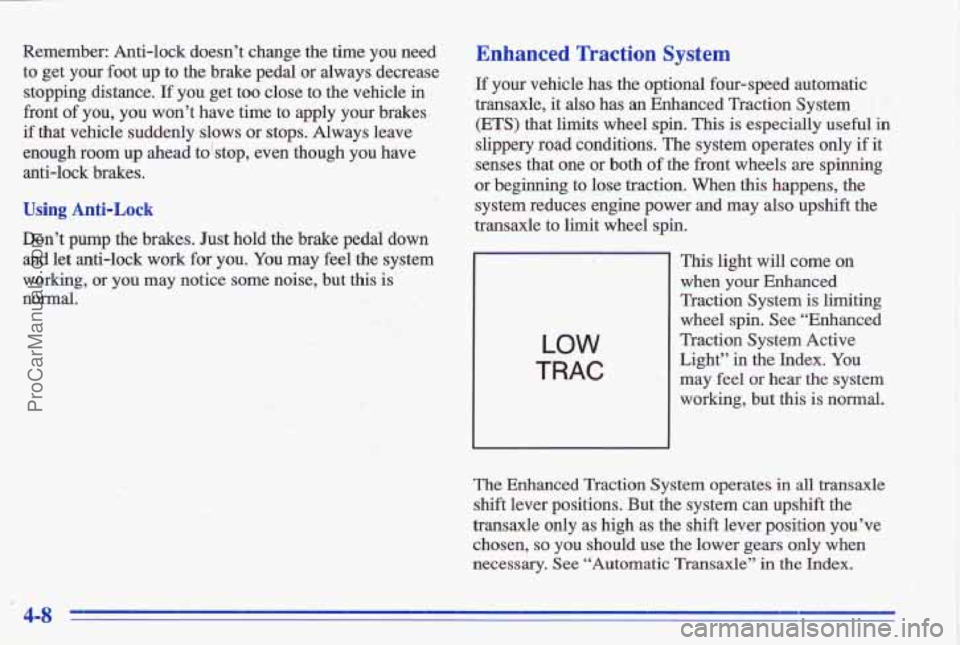
Remember: Anti-lock doesn’t change the time you need
to get your foot up to the brake pedal or always decrease
stopping distance.
If you get too close to the vehicle in
front of you, you won’t have time to apply your brakes.
if that vehicle suddenly slows or stops. Always leave
enough
room up ahead to(stop, even though you hav’e
anti-lock
brakes.
Using AntkLock
Don’t pump the brakes. Just hold the brake pedal down
and let anti-lock work for you.
You may feel the system
working, or you may notice some noise, but this is
normal.
Enhanced Traction System
If your vehicle has the optional four-speed automatic
transaxle, it
also has an Enhanced Traction System
(ETS) that limits wheel spin. This is especially useful in
slippery road condittons. The system operates only if it
senses that one or both of the front wheels we spinning
or beginning to lose traction. When this happens, the
system reduces engine power and may also upshift the
transaxle to limit wheel spin.
I
LOW
TRAC
This light will come on
when your Enhanced
Traction System is limiting
wheel
spin. See “Enhanced
Traction System Active
Light”
in the Index. You
may feel or hear the system
working, but this
is normal.
The
Enhanced Traction System operates in all transaxle
shift lever positions. But the system can upshift the
transaxle only
as high as the shift lever position you’ve
chosen,
so you should use the lower gears only when
necessary.
See “Automatic Transaxle” in the Index.
4-8 -
ProCarManuals.com
Page 157 of 356
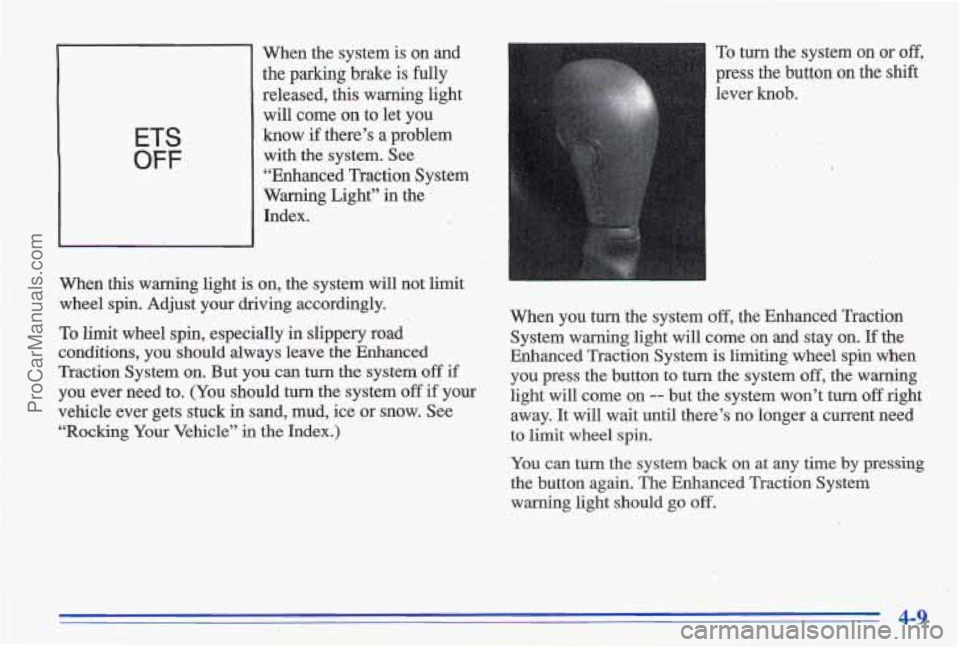
ETS
OFF
~~~
When this warning light is When the system
is on and
the
parking brake is fully
released, this warning light
will come
on to let you
know if there’s a problem
with the system. See
“Enhanced Traction System
on, the system will not limit
To turn the system on or off,
press the button on the shift
lever knob.
wheel spin. Adjust your driving accordingly. When you turn ‘the system off, the Enhanced Traction
To limit wheel spin, especially in slippery road System warning light will come on and stay on. If the
conditions, you should always leave the Enhanced Enhanced Traction System is limiting wheel spin when
Traction System
on. But YOU Can turn the system Off if . you press the button to turn the system off, the warning
you ever need to. (YOU should turn the system
Off if your
light will come on -_ but the system won’t turn off right
vehicle ever gets stuck in sand, mud, ice or snow. See
away. It will wait until there’s no longer a current need
“Rocking Your Vehicle”
in the Index.) to limit wheel spin.
You can turn the system back on at any time
by pressing
’ the button again. The Enhanced Traction System
warning light should go off.
4-9
ProCarManuals.com
Page 161 of 356
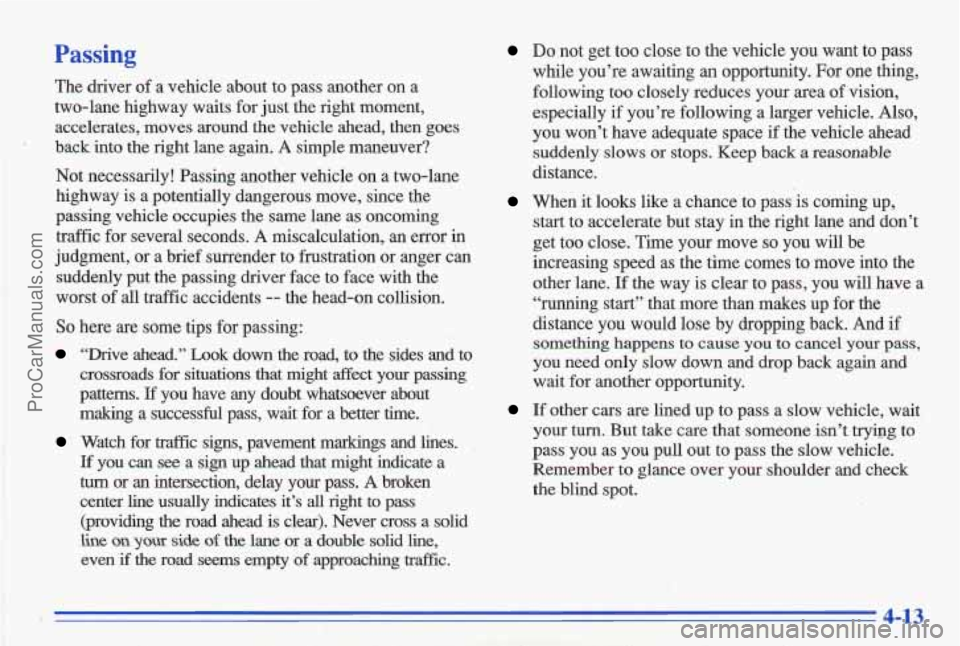
Passing
The driver of a vehicle about to pass another on a
two-lane highway waits for just the right moment,
accelerates, moves around thle vehicle ahead, then goes
” back into the right lane again. A simple maneuver?
Not necessarily! Passing another vehicle on a two-lane
highway is a potentially dangerous move, since the
passing vehicle occupies the same lane a5 oncoming
traffic for several seconds.
A miscalculation, an error in
judgment, or
a brief surrender to frustration or anger can
suddenly put the passing driver face to face with the
worst of all traffic accidents
-- the head-on collision.
So here are some tips for passing:
“Drive ahead.” Look down the road, to the sides and to
crossroads for situations that might affect your passing
patterns.
If you have any doubt whatsoever about
making .a successful pass, wait for a better time.
Watch for traffic signs, pavement markings and lines.
Lf you can see a sign up ahead that might indicate a
turn or an intersection, delay your pass. A broken
center line usually indicates it’s
all right to pass
(providing
the road ahead is clear). Never cross a solid
line on yous side of the lane or a double solid line,
even if the road seems empty of approaching traffic.
i( . . ’.-, . .‘ d“. . .. . * ,) .: ’ ;
Do not get too close to the vehicle you want to pass
while you’re awaiting
an opportunity. For one thing,
following too closely reduces your area of vision,
especially
if you’re following a larger vehicle. Also,
you won’t have adequate space
if the vehicle ahead
suddenly slows or stops. Keep back a reasonable
distance.
When it looks like a chance to pass is coming up,
start to accelerate but stay in the right lane and don’t
get too close. Time you move
so you will be
increasing speed as the
time comes to move into the
other lane.
If the way is clear to pass, you will have a
“running start” that more than makes up for the
distance
you would lose by dropping back. And if
something happens to cause you to cancel your pass,
you need only slow down and drop back again and
wait for another opportunity.
If other cars are lined up to pass a slow vehicle, wait
your turn. But take care that someone isn’t tryigg to
pass you as you pull out to pass the slow vehicle.
Remember to glance over your shoulder and check
the blind spot.
4-13
ProCarManuals.com
Page 162 of 356
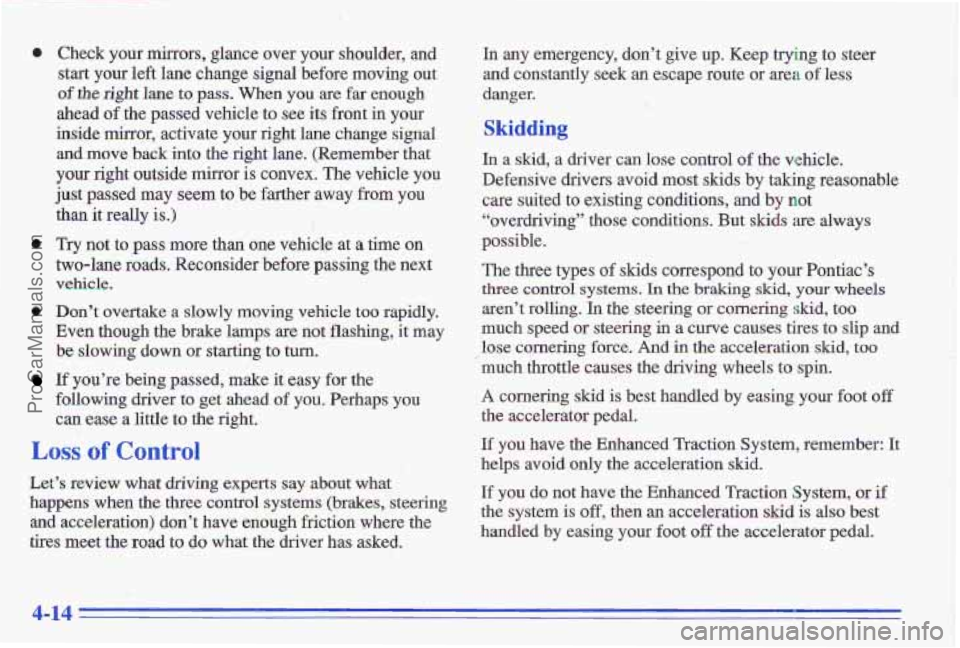
0
0
a
Check your mirrors, glance over your shoulder, and start your left lane change signal before moving out
of the right lane to pass. When you are far enough
ahead
of the passed vehicle to see its front in your
inside mirror, activate your right lane change signal and move back into the right lane. (Remember that
your right outside mirror
is convex. The vehicle you
just passed may seem
to be farther away from you
than it redly is.)
Try not to pass more than one vehicle at a time on
two-lane roads. Reconsider
before passing the next
vehicle.
Don’t overtake a slowly moving vehicle too rapidly.
Even though the brake lamps are not flashing, it may
be slowing down or starting to turn.
If you’re being passed, make it easy for the
following driver to get ahead of you. Perhaps you
can ease a little to the right.
In any emergency, don’t give up. Keep trying to steer
and constantly seek
an escape route or area of less
danger.
Skidding
In a skid, a driver can lose control of the vehicle.
Defensive drivers avoid most skids by
taking reasonable
care suited
to existing conditions, and by not
“overdriving” those conditions. But skids are always
possible.
The three types
of skids correspond to your Pontiac’s
three control systems. In the braking skid, your wheels
aren’t rolling. In the steering or cornering skid, too
much speed or steeiing
in a curve causes tires to slip and
lose cornering force. And
in the acceleration skid, too
much throttle causes the driving wheels to spin.
A cornering
skid is best handled by easing your foot off
the accelerator pedal.
If you have the Enhanced Traction System, remember: It
helps avoid only the acceleration skid.
If you do not have the Enhanced Traction System, or if
the system is off, then an acceleration skid is also best
handled by easing your foot
off the accelerator pedal.
Loss of Control
Let’s review what driving experts say about what
happens
when the three control systems (brakes, steering
and acceleration) don’t have enough friction where the
tires meet the road to do what the driver has asked.
4-14
ProCarManuals.com